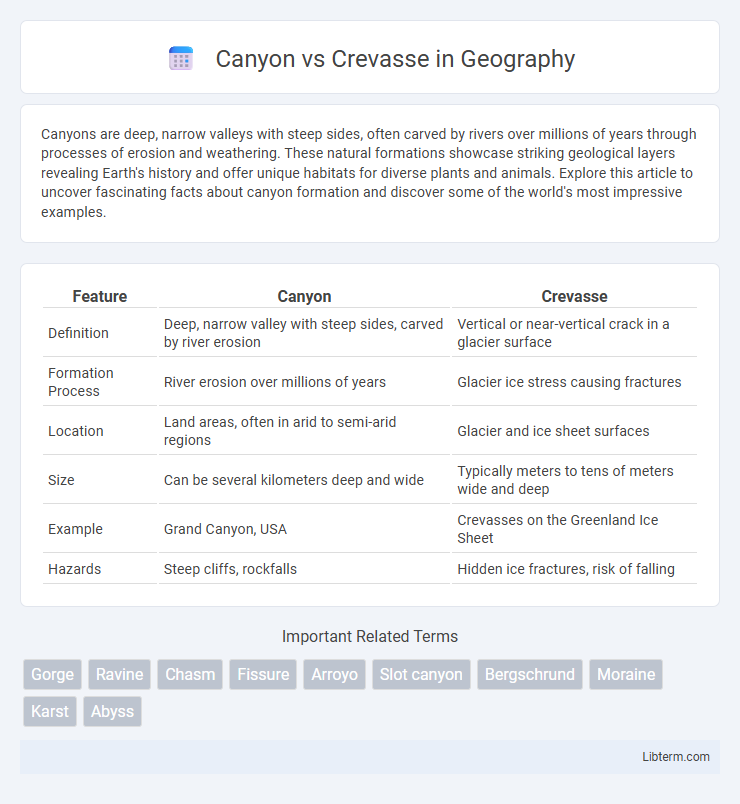Canyons are deep, narrow valleys with steep sides, often carved by rivers over millions of years through processes of erosion and weathering. These natural formations showcase striking geological layers revealing Earth's history and offer unique habitats for diverse plants and animals. Explore this article to uncover fascinating facts about canyon formation and discover some of the world's most impressive examples.
Table of Comparison
| Feature | Canyon | Crevasse |
|---|---|---|
| Definition | Deep, narrow valley with steep sides, carved by river erosion | Vertical or near-vertical crack in a glacier surface |
| Formation Process | River erosion over millions of years | Glacier ice stress causing fractures |
| Location | Land areas, often in arid to semi-arid regions | Glacier and ice sheet surfaces |
| Size | Can be several kilometers deep and wide | Typically meters to tens of meters wide and deep |
| Example | Grand Canyon, USA | Crevasses on the Greenland Ice Sheet |
| Hazards | Steep cliffs, rockfalls | Hidden ice fractures, risk of falling |
Understanding Canyons and Crevasses
Canyons are deep, narrow valleys with steep sides formed by long-term erosion from rivers cutting through rock layers over millions of years. Crevasses are deep fractures or cracks in glacier ice caused by the movement and stress within the flowing ice. Both features represent geological processes but differ significantly in formation, location, and material composition.
Formation Processes: Canyon vs Crevasse
Canyons form primarily through long-term erosion by rivers cutting deep into bedrock, exposing steep walls shaped over millions of years. Crevasses develop in glaciers as tensile stress stretches the ice, creating deep fractures that result from differential movement within the glacier. While canyons reflect riverine and geological dynamics, crevasses are direct indicators of glacial stress and ice flow behavior.
Geological Locations and Environments
Canyons are deep, narrow valleys with steep sides formed primarily by river erosion over millions of years, commonly found in arid or semi-arid regions such as the Grand Canyon in the United States. Crevasses are deep cracks or fractures in glacier ice, occurring in polar and mountainous environments, notably within ice sheets like those in Antarctica and Greenland. The geological environments of canyons involve sedimentary rock layers and river systems, while crevasses develop in dynamic glacial ice undergoing stress and movement.
Physical Characteristics and Dimensions
A canyon is a deep, narrow valley with steep sides, often formed by river erosion over millions of years, and can span several kilometers in length and hundreds of meters in depth. In contrast, a crevasse is a deep, narrow crack or fracture found primarily in glacier ice, typically measuring a few meters wide but potentially extending tens of meters deep. While canyons exhibit extensive horizontal and vertical dimensions shaping landscapes, crevasses are smaller-scale features that indicate ice movement within glaciers.
Common Examples Worldwide
The Grand Canyon in the United States exemplifies a massive canyon formed by the Colorado River's erosion over millions of years, showcasing steep walls and vast depths. The Khumbu Icefall in the Himalayas represents a notable crevasse field, where deep, narrow cracks form in moving glacier ice, posing hazards to mountaineers. Other famous canyons include the Fish River Canyon in Namibia and the Yarlung Tsangpo Grand Canyon in Tibet, while prominent crevasses appear in Antarctica's Ross Ice Shelf and Alaska's Matanuska Glacier.
The Role of Water and Ice
Water plays a critical role in shaping both canyons and crevasses through erosion and melting processes. Canyons are primarily formed by the persistent flow of rivers eroding rock layers over millions of years, carving deep valleys into the landscape. Crevasses develop in glaciers where stress causes ice to crack, with melting water deepening these fissures and influencing glacier movement.
Human Interaction and Exploration
Canyons, with their accessible trails and scenic viewpoints, have historically attracted human explorers, hikers, and indigenous populations who utilize these formations for travel, shelter, and cultural practices. Crevasses, found primarily in glacier environments, pose significant dangers to climbers and researchers, requiring specialized equipment and expertise for safe navigation and study. Human interaction within canyons is generally more frequent and recreational, whereas crevasse exploration remains limited to scientific and mountaineering activities due to inherent risks.
Dangers and Safety Considerations
Canyons pose dangers such as flash flooding, falling rocks, and steep drops, requiring safety precautions like checking weather forecasts, wearing helmets, and using proper climbing gear. Crevasses present hazards primarily in glacier environments, including hidden ice cracks and deep falls that necessitate rope travel, crevasse rescue training, and glacier navigation skills. Both environments demand awareness of terrain-specific risks and emergency preparedness to prevent accidents and ensure safety.
Ecological Impact and Biodiversity
Canyons, formed by long-term erosion, often host diverse ecosystems with unique microhabitats supporting varied plant and animal species, enhancing regional biodiversity. In contrast, crevasses, as deep cracks in glaciers, create transient habitats primarily influencing cold-adapted microorganisms and limited fauna, with less pronounced ecological impact. The stability and scale of canyons contribute to more complex ecological networks compared to the dynamic and often inhospitable conditions within crevasses.
Conclusion: Key Differences and Significance
A canyon is a deep, narrow valley with steep sides formed by long-term erosion from a river, while a crevasse is a deep crack or fracture in a glacier or ice sheet caused by stress and movement. Canyons often span large geographic areas and host diverse ecosystems, whereas crevasses are transient features critical for glaciological studies and safety in ice-covered regions. Understanding these distinctions highlights their geological importance and the different processes shaping Earth's landscape and cryosphere.
Canyon Infographic

 libterm.com
libterm.com